Have you heard about sous vide? That’s pronounced soo veed for the uninitiated. It’s a new method of cooking. Oh my goodness, is it ever a new method of cooking. Most people I talk to have never heard of it. You’re going to see sous vide cooking here on my blog now, since I’m embracing it for some of my cooking (not all, however). It utilizes a very precise temperature controlled water bath to cook food (mostly meat, although it’s also used for cooking fruits and vegetables as well). This post is all about the technique.
Archives
Recent Posts
Currently Reading
Tasting Spoons
Posted in Appetizers, on March 4th, 2012.
We’re so tuned into salsa with JUST tomatoes, onions, chiles and cilantro. But here’s one with some fresh oranges added. Delicious!
Sorry my photos aren’t a bit more clear. I took them at a cooking class and used my iPhone instead of my big honkin’ Canon DSLR. This salsa, though, was delicious, even if you can’t quite figure that out from a photo.
If you don’t mind making your own salsa, or even if you want to add oranges to some store-bought stuff, you’ll have a completely different taste sensation. What you see there is just chopped tomatoes (seeded), the chopped-up oranges (in this case, they were Cara Cara oranges from Sunkist, the folks who invited me to the class). With the addition of a few other things . . . the making of it is cinchy easy – to the tomatoes and orange add some cilantro, red onion, jalapeno chile (or any other chile of your preference), lemon juice and salt. That’s it! See? Easy. Use it with chips, or as a topping for fish or chicken. If you’re not fond of hot chiles, leave them out altogether. You might try adding some fresh basil to it instead, or even dried oregano. The oranges are available in markets just now (February-March) through April. Seek them out if you can. A few regular markets carry them, but the high end ones surely do, and even farmer’s markets will.
What I liked: the delightful addition of oranges – gives it a different flavor altogether. We had it with chips, but I’d like to try it with a grilled piece of white fish, like halibut or swordfish.
What I didn’t like: nothing at all. I’d make it again, definitely.
printer-friendly PDF
MasterCook 5+ import file – right click to save file, run MC, then File|Import
Orange and Tomato Salsa
Recipe By: Adapted slightly from Robert Danhi, chef
Serving Size: 4
1/2 cup orange sections — peeled, diced, Navel type or Cara Cara
2 whole Roma tomatoes — seeded, chopped
1 tablespoon red onion — minced
1 teaspoon jalapeno pepper — fresh, minced
1 tablespoon fresh lemon juice — or more if needed
1/2 teaspoon salt — or more if needed
3 tablespoons fresh cilantro — minced
1. In a medium bowl combine all the ingredients and mix well.
2. If time permits, chill for an hour or two just to marry the flavors. Taste for seasoning (salt and lemon juice particularly). Serve with chips, or as a topping on fish or chicken.
Per Serving: 26 Calories; trace Fat (7.1% calories from fat); 1g Protein; 6g Carbohydrate; 1g Dietary Fiber; 0mg Cholesterol; 273mg Sodium.
Are all scones beautiful? Certainly not if you look at mine! But, these have a nice rich, tender scone texture with all those lovely spices (similar to pumpkin pie), some crystallized ginger, and pumpkin puree.
Can you just tell these scones are craggy? I love that word – craggy. Means rugged and uneven: a craggy face, for instance. These are not your more common – pretty, perfectly formed triangular scones with smooth tops and edges. The dough is raggedy and slightly bumpy. Even a tad on the difficult to form. But I didn’t over-handle it just so it wouldn’t get tough. I needed a breakfast bread for my DH’s men’s Bible Study group, and went to my internet file, and there was this one. It came from King Arthur Flour about 2 years ago, and if you want to see their version, click here.
My pantry shelf still had two large cans of pumpkin puree from 2010. Long past its use by date, but I know those dates are just suggestions. Canned goods usually don’t have a problem for several years. But I only used 2/3 of a cup of the pumpkin, so I’ll have to find something else to use some of the remainder. I could freeze it, but that’s taking up valuable real estate in my freezer. Not what I want to do with it for sure! If I had 3 freezers, they’d all be full. I just know it. But those kinds of confessions are for another post . . .
The scones were cinchy easy to make – flour, baking powder, sugar, some spices (cinnamon, allspice, ginger and nutmeg), a cube of butter, a couple of eggs and the pumpkin puree. That’s all there is in it. As I mentioned the dough was a little on the dry side – I ended up adding a couple of tablespoons more pumpkin to help bring it together. I could have added some milk instead, but with so little pumpkin in it, I knew a little more wouldn’t hurt. You could easily makes these in rounds, or the triangles – whatever you prefer. I molded the dough into a kind of rectangle and cut the wedges easily enough.
One unusual step was putting the baking sheet (with raw scones on it) in the freezer for 30 minutes. I’d guess that’s to freeze the butter – or at least chill it a lot – helps to make tender pastry products. Into an oven it went. I looked up what the finished temp is supposed to be (the internal temp) for scones, and found out it was 200°, so that’s exactly how long I baked them. Actually it went a couple degrees over that.
Right out of the oven one of those scones yelled out to me – I had to taste one, right – this is quality control! They’re delicious. I made half a recipe (6) so those were mostly eaten by the guys. I knew if I wanted to know how they tasted I needed to eat one. Actually I cut them slightly smaller and had 7, so eating one was just right!
What I liked: the very tender crumb. The pumpkin flavors – the pumpkin itself, but also the spices. AND the crystallized ginger. Love that stuff! I’m a fan of crystallized ginger, so I loved the little bit of sweet-tart crunch from the little nuggets. Worth making.
What I didn’t like: the dough was a bit hard to shape – not un-do-able, just craggy, as I mentioned. Didn’t make a whit of difference to the taste, which was really good!
MasterCook 5+ import file – right click to save file, run MC, then File|Import
Harvest Pumpkin Scones
Recipe By: King Arthur Flour blog
Serving Size: 12
NOTES: If the mixture is dry, add a tablespoon more canned pumpkin puree. If too wet, add just a bit of flour until it’s malleable.
2 3/4 cups all-purpose flour
1/3 cup sugar [I used Splenda]
1 tablespoon baking powder
3/4 teaspoon salt
3/4 teaspoon ground cinnamon
1/4 teaspoon ground ginger
1/4 teaspoon ground nutmeg
1/4 teaspoon ground allspice
1/2 cup cold butter
1 cup crystallized ginger — minced, or cinnamon chips, or chocolate chips, or up to 2 cups
2/3 cup canned pumpkin
2 large eggs
coarse white sparkling sugar — for topping, optional
1. In a large mixing bowl, whisk together the flour, sugar, baking powder, salt, and spices.
2. Work in the butter just until the mixture is unevenly crumbly; it’s OK for some larger chunks of butter to remain unincorporated.
3. Stir in the ginger and/or chips, if you’re using them.
4. In a separate mixing bowl, whisk together the pumpkin and eggs till smooth.
5. Add the pumpkin/egg to the dry ingredients and stir until all is moistened and holds together.
6. Line a baking sheet with parchment; if you don’t have parchment, just use it without greasing it. Sprinkle a bit of flour atop the parchment or pan.
7. Scrape the dough onto the floured parchment or pan, and divide it in half. Round each half into a 5″ circle (if you haven’t incorporated any add-ins); or a 6″ circle (if you’ve added 2 cups of fruit, nuts, etc.). The circles should be about 3/4″ thick.
8. Brush each circle with milk, and sprinkle with coarse white sparkling sugar or cinnamon sugar, if desired.
9. Using a knife or bench knife that you’ve run under cold water, slice each circle into 6 wedges.
10. Carefully pull the wedges away from the center to separate them just a bit; there should be about 1/2″ space between them, at their outer edges.
11. For best texture and highest rise, place the pan of scones in the freezer for 30 minutes, uncovered. While the scones are chilling, preheat the oven to 425°F.
12. Bake the scones for 22 to 25 minutes, or until they’re golden brown (to an internal temp of 200° or a toothpick inserted into the center of one comes out clean, with no wet crumbs). If you pull one of the scones away from the others, the edges should look baked through, not wet or doughy.
13. Remove the scones from the oven, and serve warm. Wrap any leftovers airtight, and store at room temperature. Reheat very briefly in the microwave, if desired.
Per Serving: 260 Calories; 9g Fat (30.4% calories from fat); 4g Protein; 41g Carbohydrate; 1g Dietary Fiber; 56mg Cholesterol; 355mg Sodium.
Posted in Beverages, on February 29th, 2012.
Everybody’s had a mimosa, right? That lovely brunch-time drink that’s a mixture of orange juice and champagne? Well, this recipe has a similar ancestry, but it’s so much better. With so much more flavor (from the brandy, and the addition of a simple syrup mixture).
This drink is sweeter (obviously since there is the simple syrup added), although you could alter the ratio of the brandy syrup to champagne. That’s completely up to you.
 The recipe came from a special class I attended recently, complements of Sunkist. And this recipe was developed specifically for the Cara Cara orange.
The recipe came from a special class I attended recently, complements of Sunkist. And this recipe was developed specifically for the Cara Cara orange.
What’s a Cara Cara Orange? Well, it’s a Navel orange. Not a hybrid with red grapefruit or blood oranges, as you might think since it has the prettiest rosy color. The orange was discovered in Venezuela in 1976. It’s a cross between the Washington navel and the Brazilian Bahia navel, and growers discovered it thrives here in California. Oddly, they’re not all that easy to find, and there doesn’t seem to be any reason why that I can find. Probably because we’re just primed for regular Navels. But I liked the deeper flavor – and the color. If you can’t find cara cara oranges, just use Navel oranges instead.
In this recipe, you combine juice, zest, sugar, water and brandy (or cognac if you’re willing to use the good stuff) and simmer it until it’s reduced about half. The mixture is cooled, strained of any pulp and zest, and chilled. When you’re ready to serve this, just spoon in 1 1/2 ounces of the brandy syrup into a champagne flute, pour in a bit of champagne and garnish with a nice Cara Cara orange segment. Done. Easy. Delicious.
What I liked: the pretty color. The lovely taste – the brandy adds a depth of flavor – you can’t really pick out the brandy – you just know it has something else in it!
What I didn’t like: nothing at all. Do make it for your next brunch!
printer-friendly PDF
Master Cook 5+ import file – right click to save file, run MC, then File|Import
Orange Sparkler
Recipe By: Altered slightly from a Sunkist Growers recipe by Robert Danhi.
Serving Size: 2-4
FOR BRANDY SYRUP:
1/2 cup orange juice — from Cara Cara oranges, or Navels
1/2 tablespoon orange zest
1/3 cup granulated sugar
1/4 cup water
1/4 cup brandy — or cognac
FOR EACH DRINK:
1 1/2 ounces brandy syrup
5 ounces sparkling wine — Champagne, or other type of white sparkling wine
1 piece orange section
1. In a medium-sized, heavy saucepan (taller rather than wider if possible) add the orange zest, orange juice, sugar, water and brandy and bring to a boil. Reduce heat and simmer for about 10 minutes until mixture has reduced about 40-50%, stirring frequently with a wire whisk (be careful it doesn’t boil over). Allow to cool, then strain mixture into a small jar and chill. The mixture will keep for several days.
2. In each tall champagne flute add the brandy syrup, sparkling wine, then the fresh orange segment. Serve.
Posted in Salad Dressings, Salads, on February 27th, 2012.
You might not think roasted carrots could be in/on a green salad. Let me assure you, you will be delightfully surprised at how flavorful this salad is. Trust me!
A couple of weeks ago my friend Cherrie and I attended a cooking class with Tarla Fallgatter. Actually it was on Valentine’s Day (hence the color-clashing red/pink plates). A few nights later Cherrie made this salad when the 4 of us were visiting our friends Stacey & Russ, who live in San Jose, but I forgot to take a better photo. . .
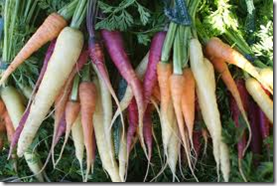 No matter what – if you like carrots – you’re going to adore this salad. I may make it today, just because looking at that photo sends my salivary glands into overdrive! When Cherrie made it she and I found some of the adorable multi-colored baby carrots at a local market (see photo left). They made a pretty presentation on the plates.
No matter what – if you like carrots – you’re going to adore this salad. I may make it today, just because looking at that photo sends my salivary glands into overdrive! When Cherrie made it she and I found some of the adorable multi-colored baby carrots at a local market (see photo left). They made a pretty presentation on the plates.
But even if you can’t find the pretty carrots, use regular orange carrots. Buy organic, though, as they have so much more flavor. You’ll want to adjust the roasting time depending on the size of the carrots. They want to be just barely cooked through – not mushy.
The dressing is so perfect for this salad – a honey mustard vinaigrette with pear vinegar. I liked the dressing well enough that I’d make it all by itself. In this salad you dress the carrots with just a bit of the dressing, and dress the salad lightly also. The recipe makes more dressing than you’ll need, which is just fine by me! More for another dinner.
What I liked: the carrots – roasted – are just intensely full of flavor. Worth making for any reason. And I particularly liked the arugula – but you can use mache instead. Whatever is available. And the dressing is particularly good too.
What I didn’t like: nothing at all. Fabulous recipe.
MasterCook 5+ import file – right click to save file, run MC, then File|Import
Roasted Carrot, Arugula and Feta Salad
Recipe By: Tarla Fallgatter, cooking instructor, Feb. 2012
Serving Size: 6
NOTES: The pear vinaigrette will probably dress at least 8 servings, if not more. If you can find multi-colored carrots (purple, yellow, white and orange) this makes a really beautifully presented salad. Otherwise, regular, large orange carrots will be just fine! The salad does not need very much dressing – be careful and don’t overdo it. Do choose a Feta that isn’t overly salty. Tarla recommended Bulgarian (because it cubes well) but I didn’t like it at all – I prefer a milder and crumbled Feta instead.
12 medium carrots — mixed colors, if available
2 teaspoons mixed spice rub
2 tablespoons olive oil
2 cups arugula — baby arugula if possible, or mache lettuce
1/2 cup micro greens — optional
1/3 cup sunflower seeds, toasted
3 ounces Feta cheese — cubed or crumbled
1 whole avocado — peeled, sliced
VINAIGRETTE (makes more than you’ll need):
2 tablespoons pear vinegar
1 teaspoon balsamic vinegar
1 pinch red pepper flakes
2 teaspoons honey mustard
4 1/2 tablespoons olive oil
1. Preheat oven to 400°.
2. Toss carrots with olive oil and spice mix and place on cookie sheet. Roast until tender, turning occasionally, about 15-20 minutes. Cool. If carrots are large, slice in half lengthwise, or in quarters, or if small, leave whole. Toss carrots with about 2 T. of the vinaigrette.
3. Toss lettuce (or arugula), micro greens and sunflower seeds together. Add a bit of dressing and toss gently, then add Feta cheese (in it, or on top). Divide among plates and place carrots decoratively on top of the salad.
Per Serving (assumes you’ll use all the dressing, which you likely will not): 334 Calories; 27g Fat (70.5% calories from fat); 6g Protein; 20g Carbohydrate; 6g Dietary Fiber; 13mg Cholesterol; 237mg Sodium.
Posted in Beef, on February 25th, 2012.
An old-world kind of meat sauce for pasta, but it’s different than anything I’ve ever made before, filled with ground meats as well as ribs and little beef rolls too. And meatballs; how could I forget the delicious little mounds you see above!
Visiting the library recently, I decided to go down the cookbook aisle and see what new ones they had on the shelves. Nothing very new, but I glanced at one Italian cookbook and decided to check it out. It was written by Eleanora Russo Scarpetta. Now, I didn’t know who she was until I started reading. She’s been a “regular” visitor on Martha Stewart’s show for several years, and after several successful visits, because lots of people asked, she decided to write a cookbook, Eleanora’s Kitchen: 125 Fabulous Authentic Italian-American Recipes. She got on Martha’s show because of her relatively easy and unique method of canning tomatoes (also in the cookbook), but Martha liked her, obviously, so she’s been back often to cook her style of Italian food.
Many of her recipes are her mother’s (this recipe included). Scarpetta is a housewife, not a TV star or a food network diva. She has children she cares for, meals to fix, grocery shopping to do, etc. She’s adapted many of her family’s recipes to our American tastes, and she definitely cooks the Italian-American style. I read all the stories and every recipe in the book. And this recipe is the only one I copied out to try. It was just unusual enough that I wanted to make it.
It does have a regular meat sauce, and it has very flavorful meatballs; but the unique thing (to me, anyway) was the addition of ribs (like baby backs or country ribs, either one) and a few small stuffed rolls of beef. In Italian the latter are called braciole (that’s a link to my own recipe for braciole).
Scarpetta explained in the write-up about this recipe that in the old-world (Italian) family, it was called “Sunday Sauce” because it was something made on Sundays, after going to Catholic mass, and they sat down to a big meal at midday, the big meal of the day. The sauce (with pasta) became the entire meal, as well it should since it contains several pounds of different meat. The Italian mama or grandmama made pasta, a salad, and served bread alongside. That was dinner, and any leftovers went into a different dish later in the week. Scarpetta also explained that in her family home first you ate a small plate of pasta with just the meat sauce on it. Then you ate the second course of the meats, meatballs, along with a salad, bread and fruit for dessert. The meat variety intrigued me, as well as the two courses. We didn’t eat it that way.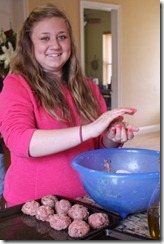
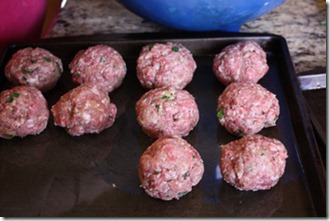 We were in northern California a week or so ago (celebrating our oldest grandson’s 18th birthday) and I suggested we try making this dish for the family. There’s a photo of our 14-year old granddaughter Taylor making the meatballs. A big job! My daughter Dana and I made the rest of the sauce.
We were in northern California a week or so ago (celebrating our oldest grandson’s 18th birthday) and I suggested we try making this dish for the family. There’s a photo of our 14-year old granddaughter Taylor making the meatballs. A big job! My daughter Dana and I made the rest of the sauce.
The sauce simmers for an hour or so. The meats are browned on all sides and added to the sauce and cooked just long enough to get them cooked through. The meatballs can be browned separately then cooked in the sauce, but we decided to bake them (an alternative) in the oven for 40 minutes, turning them once halfway through. Then they were added to the sauce and cooked for awhile.
I must make a confession here – we made the braciole according to the Sunday Sauce recipe, but we cooked it altogether too long. We made this meat sauce the day before we ate it, and we reheated it the next day and let it simmer slowly for an hour or so. That was in addition to the hour or so it had cooked the day before. Too long! So, the beef braciole were dry, chewy and mostly tasteless. A lesson learned.
Also, I must tell you that the recipe called for 2 pieces of beef cutlets. It’s been a looooong time since I read a recipe with beef cutlets, let alone seen any in the market. I didn’t even remember what they were, although my head said it was round steak. Searching on the internet I learned that lots of people think beef cutlets are cube steaks (cube steaks are round steaks that have been put through a tenderizing machine by the butcher). Well, I just thought we’d use the round steaks. I sliced it in 3 thinner steaks to stuff and roll. I pounded the heck out of them to tenderize them myself. If you decide to do that part of this recipe, take heed and don’t overcook 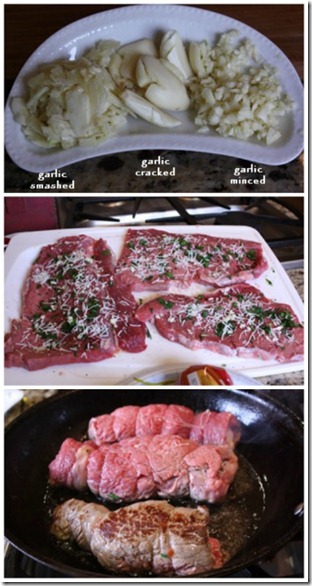 the braciole. They need 1 1/4 hours total and they’re done!
the braciole. They need 1 1/4 hours total and they’re done!
When we reheated the sauce (everything was in the one pot at this point) the pork country ribs all fell apart, so they were distributed throughout the sauce. Not what was intended I’m sure! I removed the pancetta also because it was a funny, long fatty piece by that time. We actually didn’t eat the beef braciole in with the sauce – we left it out – it had flavored the dish and would be used for something else. We also added more salt (depends on how salty the canned tomatoes or puree are as to how much is needed) AND we added some Italian seasonings. Dana and I found it odd that this sauce contained no herbs except the 3 leaves of fresh basil. That was IT. And we thought the sauce was bland. So we added some dried herbs during the last 15 minutes of cooking. Use your own combination if you’d prefer. And perhaps it was sacrilegious to do so, but it’s what we liked. It’s included in the recipe, but noted as my additions.
What I liked: first and foremost, the meatballs. I loved the flavor of them. Also the texture (with the addition of the minced up bread in it). Note that there are no herbs in the meatballs, just parsley, grated Pecorino and garlic. We also ended up putting Italian sausage in the meatballs – it was supposed to go in the sauce, but I misread the recipe and it got put into the meatballs instead. So if you make the meatballs, you might want to add some Italian sausage to it – it did have some herbs in it, obviously. I did like the sauce – probably because of the flavorings provided by the beef and the country ribs.
What I didn’t like: hmmm. Probably I should tell you that this sauce is a lot of work. I had helpers in the kitchen so that really made it easier. Would I make it again? Only if I had help. I’d definitely make the meatballs again, though (with Italian sausage added into it). Also, once I input this recipe into my recipe software, it shows about 1000 calories per serving (including the pasta). I find that hard to believe. Obviously the amount serves more than 12. Scarpetta’s recipe indicated it served 8-10. We served 7 and had at least half of it left over.
printer-friendly PDF
MasterCook 5+ import file – right click to save file, run MC, then File|Import
Sunday Sauce alla Russo
Recipe By: Adapted slightly from Eleanora’s Kitchen, by Eleanora Russo Scarpetta
Serving Size: 12 (probably more)
NOTES: We ended up adding the Italian sausage to the meatballs – it never made it into the meat sauce. So IF you decide to just make meatballs, do add some Italian sausage to it (not shown in the recipe that way). Also, be sure you don’t cook the bracioe more than 1 1/4 hours or they will become dry and tasteless. And, to be efficient, you’re going to need 10 garlic cloves: 5 pressed through a garlic press, 2 finely chopped, and 3 mostly whole (cracked).
Serving Ideas: In the traditional fashion the sauce would be served as a first course over pasta, then the meats, braciole, ribs and meatballs would be served as a second course with salad, bread, wine and fruit for dessert. You can use any kind of pasta. Leftovers can be made into lasagna, stuffed shells, manicotti, ravioli or baked ziti.
SAUCE:
1/4 cup extra virgin olive oil
1 medium onion — halved
1/4 pound pancetta — or Canadian bacon
5 cloves garlic — put through a garlic press
1/2 teaspoon salt
96 ounces canned plum tomatoes — with juice, pureed in blender for 3-5 seconds only (3 large cans)
32 ounces tomato puree — canned
6 large fresh basil leaves
3/4 pound Italian sausage — sweet (not hot)
1 tablespoon dried oregano — [added during last 15 minutes] my addition
1/2 tablespoon Italian seasoning — [added during last 15 minutes] my addition
THE MEAT:
1/4 cup extra virgin olive oil
3 whole garlic cloves — cracked (peeled and lightly smashed)
3/4 pound spareribs — or country ribs with bones
1/2 cup dry white wine
BEEF BRACIOLE:
18 ounces cube steaks — or thin round steaks, cut into 2 pieces
2 teaspoons extra virgin olive oil
1 whole garlic clove — finely minced
2 teaspoons Italian parsley — minced
2 tablespoons Pecorino Romano cheese — freshly grated
Freshly ground black pepper to taste
MEATBALLS:
3 large eggs — lightly beaten
1/2 cup Pecorino Romano cheese — grated
2 tablespoons Italian parsley — minced
1/4 teaspoon freshly ground black pepper
1 1/2 pounds ground sirloin
3/4 pound ground pork
3/4 pound ground veal — or use more ground pork
2 whole garlic cloves — finely chopped
2 tablespoons extra virgin olive oil
1/2 teaspoon salt
1 slice white bread — (or Italian bread)
3/4 cup dry bread crumbs
1/2 cup light olive oil — (i.e. not extra virgin)
PASTA:
1 1/2 pounds pasta — (your choice – we used linguine)
1. SAUCE: In a large heavy-duty pan warm 1/4 cup olive oil over medium heat. Add onion halves, pancetta (all in one piece), pressed garlic and 1/2 tsp salt and cook, stirring for about 2 minutes. Add the tomatoes, the tomato puree, fresh basil and simmer, partially covered, for 45 minutes, stirring occasionally. Discard the onion halves.
2. BRACIOLE: Place the cube steaks on a work surface (plastic cutting board). Pound the steak with a meat pounder for 2-3 minutes. Sprinkle each steak with a teaspoon of olive oil, garlic, parsley and Pecorino cheese. Season with salt and pepper to taste. Working with one steak at a time, roll tightly into a log shape and tie with kitchen twine.
3. MEATS: Heat the remaining 1/4 cup oil in a large (wide) cast-iron skillet, if possible, over medium heat. Add the cracked garlic and cook for 2 minutes (do not burn). Add the braciole, sausage and ribs to the skillet and cook, uncovered, until the meats are golden brown all over, about 8-10 minutes, turning as needed. Add the white wine and cook for 2 more minutes. Remove the browned meats from the pan and add them to the sauce, along with the meatballs (directions below).
4. Add 2 cups water to the sauce and return to a simmer. Cook, partially covered, stirring occasionally, over medium heat for 1 1/4 hours (DO NOT COOK ANY LONGER). During last 15 minutes, add the oregano and Italian seasoning (crush it between your palms to open up the oils).
5. PASTA: Just before the sauce is done, bring a large pot of lightly salted water to a boil. Add the pasta and cook according to package directions, until al dente (still a little bite to the pasta). Drain, then transfer to a large (HOT) serving platter. Serve the pasta with meat sauce, sprinkle with Pecorino Romano cheese and serve immediately.
6. MEATBALLS: In a large mixing bowl beat the eggs, then add cheese, parsley and black pepper. Add the beef, pork, veal, garlic, oil and salt. Mix to combine.
7. Hold the bread under running water for about 1-2 seconds only, then squeeze out all the water. Tear the bread (it’s a kind of mush at this point) into very small pieces and add to meatball mixture along with the bread crumbs. Mix well.
8. With damp hands, working with 1/4 cup of meat at a time, form into meatballs and set on a baking sheet (rimmed). Do not allow meatballs to touch one another.
9. Preheat oven to 350°.
10. Bake meatballs for 20 minutes; turn them over and bake another 20 minutes. Drain and add them to the sauce mixture above.
Per Serving (probably serves more than 12, which is why the calorie count is so high): 1057 Calories; 62g Fat (53.4% calories from fat); 54g Protein; 68g Carbohydrate; 6g Dietary Fiber; 207mg Cholesterol; 1560mg Sodium.
A simple, but very spicy and flavorful chicken curry, served over basmati rice. You can adapt the vegetables to your choice (this one uses red, yellow and orange bell peppers and onion).
It was about 3 years ago I was reading Cook Sister’s blog and put this recipe into my software to try someday. I have an “internet” category within my recipe software, so I know I got the recipes somewhere on the web. Jeanne (that’s Cook Sister) is South African, but the recipe is Indian. What I liked about the recipe was Jeanne’s long list of spices. Actually, I think her husband Nick made the dish, but it’s Jeanne’s blog. More spices = more flavor in my cooking book, if you get my drift. And since I have coriander, green cardamom, cumin seeds and powder, turmeric, and garam masala in my spice pantry, it was just a matter of opening a bunch of different bottles to get this spice rub and sauce enhancer going. Don’t get bogged down when you see how many spices are in this dish – you need them to make this dish taste so darned good!
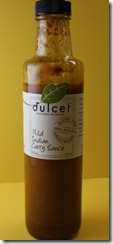 Jalfrezi is a curry dish that is generally marinated in spices, then made into an all-in-one pan dish with bell peppers and onion. It can have many different proteins in it (chicken, fish, beef, even paneer [a cheese]). And that’s really all it is. It took me about 30 minutes to make the dish from beginning to end (except for the 2-3 hours of marinating, that is).
Jalfrezi is a curry dish that is generally marinated in spices, then made into an all-in-one pan dish with bell peppers and onion. It can have many different proteins in it (chicken, fish, beef, even paneer [a cheese]). And that’s really all it is. It took me about 30 minutes to make the dish from beginning to end (except for the 2-3 hours of marinating, that is).
I did adapt this recipe some – when I read the directions I decided to simplify them a little bit – and I decided to add some of this sauce you see pictured at left. Dulcet is a new brand of products that you can find in some markets, and this sauce was recommended to me by a friend, a Mild Indian Curry Sauce. I suppose I could have used the entire bottle in this preparation, but I just decided to use some of it and use the recipe for the balance. If you don’t have this sauce, don’t worry – just make it without it. The sauce makes a really dark amber-colored mixture. Oh, so full of flavor.
What I liked: how easy it was to make. And how flavorful it was. My dinner came together in not time once I set the rice cooker going and cut up the onions and peppers.
What I didn’t like: nothing at all. My DH loved this dish. Fortunately for him/us, I had leftovers which I put in the freezer for a later dinner.
printer-friendly PDF
MasterCook 5+ import file – right click to save file, run MC, then File|Import
Chicken Jalfrezi
Recipe By: Adapted from Cook Sister blog, 2009
Serving Size: 6
NOTES: Note that you use most of the spices in the marinade AND in the chicken preparation, so the easiest thing to do is put all of the dry spices together and separate for each use. If you don’t have the multi-colored bell peppers, use what you can get – all red, all yellow or whatever. I don’t like green bells, so I never use those, but you could easily use all green bells if you like them.
MARINADE:
1/2 teaspoon ginger — mashed to a paste
1/2 teaspoon garlic — smashed and minced
1/2 teaspoon turmeric
1/2 teaspoon garam masala
1/2 teaspoon salt
1 teaspoon vegetable oil
CHICKEN:
3 boneless skinless chicken breast halves — diced into 1-inch cubes
1 large onion — thinly sliced
1 whole orange bell pepper — slivered
1 whole red bell pepper — slivered
1 whole yellow bell pepper — slivered
2 tablespoons tomato paste
1 stick cinnamon
1/2 teaspoon ginger — mashed to a paste
1/2 teaspoon garlic — mashed and minced
1/2 teaspoon cumin powder
1/2 teaspoon ground coriander
1/2 teaspoon turmeric
1/2 teaspoon garam masala
1/2 teaspoon cumin seeds
2 whole cardamom — green pods, left whole
2 tablespoons vegetable oil
1 cup water
3 tablespoons Dulcet Indian curry sauce — optional
1 teaspoon Sriracha sauce — or other hot sauce to taste
Salt to taste
1. Mix marinade ingredients, add the chicken cubes and mix until each cube is coated. Allow to marinate for 2-3 hours. Heat 1 Tbsp of oil in a non-stick pan and fry the chicken pieces until the pieces start turning brown. Remove pieces and set aside.
2. Heat rest of the oil in same pan and add the cumin seeds, cardamom pods and cinnamon stick and cook until fragrant. After a few minutes, add the ginger and garlic and sauté for another couple of minutes. Do not burn. (Remove cinnamon stick and cardamom pods if you prefer – otherwise you may bite down on one of them when you eat this.)
3. Add the onions and all the peppers and sauté for a couple of minutes until the onions turn translucent, but not brown. Remove from the pan and set aside.
4. To the same pan, add the chicken pieces, tomato paste, and all the remaining spices. Let the chicken cook over low heat uncovered until it is well-coated with spices. Add about 1 cup of water and salt and simmer covered over medium heat flame 10 minutes till the chicken is almost cooked. Add Dulcet bottled sauce, if using, and hot sauce to taste.
5. Add the reserved peppers and onions back into the pan and let it all cook together for another 10 minutes until chicken is done and the sauce has reached the consistency that you like. Taste sauce for seasoning – add more water to the pan if the fluid evaporates too much. You want enough sauce so it will soak into the rice somewhat.
6. Serve over steamed basmati rice and garnish with minced cilantro.
Per Serving (the rice isn’t included, but even with it, it’s very low calorie): 155 Calories; 7g Fat (37.1% calories from fat); 15g Protein; 10g Carbohydrate; 3g Dietary Fiber; 34mg Cholesterol; 285mg Sodium.
Posted in Soups, on February 21st, 2012.
Our friend James shared a bit of leftover soup with us, and it was perfect for our dinner the other night with a grilled vegetable sandwich. I’d forgotten all about Senate Bean Soup. Have you ever had it? According to my notes in my trusty little 3-ring binder, I wrote out [my] recipe in March of 1971. Where I found it, I don’t know. You can find the original recipes at the U.S. Senate’s website. It’s nice that the Senate shares the two recipes since they are almost like a national treasure! The history is very interesting – I’d forgotten all about it:
Bean soup is on the menu in the Senate’s restaurant every day. There are several stories about the origin . . . but none has been corroborated. According to one story, the Senate’s bean soup tradition began early in the 20th-century at the request of Senator Fred Dubois of Idaho. Another story attributes the request to Senator Knute Nelson of Minnesota, who expressed his fondness for the soup in 1903. The recipe attributed to Dubois includes mashed potatoes and makes a 5-gallon batch. The recipe served in the Senate today does not include mashed potatoes, but does include a braised onion.
My version includes both onion and mashed potato, so I guess it’s a marriage of both recipes. I poked all around the internet looking at various versions of this soup – some include herbs (only parsley in mine) and additional vegetables (only celery and onions in the authentic version). One included a dash of nutmeg. I thought that sounded good. Add it if you’d like. I found a chowhound page with lots of interesting information about the Senate dining room’s menu in 1968. I didn’t think the Senate dining room was open to the public (now), and the Senate’s website doesn’t indicate that it is, but one of the comments on chowhound said it was. I do believe when I was a teenager, in my family’s driving trip across the country, when we stayed in Washington DC for 3 days, en route for our 3-year move to Newport, Rhode Island, we ate there. Amazing that I remember that amidst all the trivia taking up space in my brain! I had the Senate Bean Soup – because even then (this was in 1956) the Senate Bean Soup had a huge reputation. And today it’s still a very inexpensive menu item (under $2.00 per serving).
Our friend who made this pot of soup bought the ham at Honey Baked Ham. They sell a package of dried beans and it includes a ham bone. It’s quite pricey that way (online, shipped), so I think I’d suggest finding a ham bone at the grocery store and just buying the navy beans (not a multicolored mix). Although maybe if you visit the store directly it may be more reasonable.
At any rate, the soup is cinchy simple to make – just soak the beans overnight and everything can be simmered on the stove for a couple of hours. You do have to chop up the ham, though, from the ham bone. That might take a bit of time – not only the cutting, but you need to let it cool long enough so you can pick it apart and chop it up. It takes hands, not just a knife to accomplish that. And the bean mixture is best if it’s pureed in the blender. Some recipes don’t have you take that step. My recipe said to remove almost all of the bean mixture to puree it. James pureed all of his, and I really liked it that way. Once it’s pureed, add more water if you’d like a thinner, smoother soup. It doesn’t need to be super-thick to be tasty. Thanks, James, for the reminder about how good this soup can be!
What I liked: how simple it is to make. And it’s full of good flavor too. Note that there is no added fat in the recipe – any fat comes from the ham.
What I didn’t like: absolutely nothing. Worth making for sure.
printer-friendly PDF
MasterCook 5+ import file – right click to save file, run MC, then File|Import
Senate Bean Soup
Recipe By: A recipe from my 3-ring binder, dated 1971. It’s very similar to the published (online) Senate Bean Soup.
Serving Size: 6
1 pound dried navy beans
2 quarts water
1 1/2 pounds ham hock — with ample meat on it
3 whole onions — chopped
2 cloves garlic — minced
2 stalks celery — chopped
1 cup mashed potatoes — or 2/3 cup dry instant potatoes
4 tablespoons parsley — chopped
Salt and pepper to taste
1. Soak dried beans overnight covered by a couple of inches of cold water.
2. Drain and add 2 quarts of water and ham bone. Bring to a boil, reduce heat and simmer for about 2 hours. Add onions, garlic, celery, parsley and mashed potatoes and continue simmering for an hour longer or until the mixture is tender.
3. Remove ham bone and set aside. When cool enough to handle, chop the ham meat into small cubes. (Don’t add it yet to the soup.)
4. Puree the soup in a blender until smooth. Return mixture to pot and add the ham. Add more water if you’d prefer a thinner soup. Reheat and serve with additional chopped parsley on top.
Per Serving: 606 Calories; 23g Fat (34.4% calories from fat); 44g Protein; 56g Carbohydrate; 20g Dietary Fiber; 121mg Cholesterol; 187mg Sodium.
Posted in Beef, Miscellaneous, on February 19th, 2012.
This barbecue sauce is so different than almost anything you’ve ever tasted. Who would ever – ever – think of making a barbecue sauce with watermelon? You need to like sweet BBQ sauce, however, to like this. It’s really very sweet. If that meets with your taste, you’ve just got to try this.
A couple of weeks ago I went to a cooking class with a different instructor. It was all about flank steak (pictured above). I really thought we were going to learn all about the meat itself – the chemistry of it, I suppose – the why of flank steak recipes. Flank steak is such a different cut of meat. Not that the instructor didn’t mention a couple of facts about flank steak – she did – but it was about 2 sentences and then she was off and running with a recipe. I expected at least one recipe (out of 5) that required a marinade, when in fact, not even one of them was marinated.

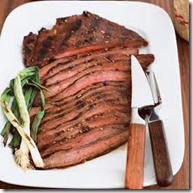 Now my understanding about flank steak is that, of course, it’s extremely lean. Probably the leanest beef cut in the animal.
Now my understanding about flank steak is that, of course, it’s extremely lean. Probably the leanest beef cut in the animal.
Here in the photo at left you can definitely see the lengthwise striations (the grain) in the meat – an important point since those long meat strands contribute to the toughness of the meat. Your butcher will have removed the fat flap and silverskin, so all you really see is the very lean meat. In the photo at right you can see the very thin slices that are ideal for flank. The thinner the better. You always want to slice flank steak across the grain. And if you can do it on an angle, you’ll get a nicer (bigger) slice of meat, and it’s a more attractive portion for serving.
 Flank steak used to be considered a poor man’s meat, since the cut was not as desirable as other steak types. And it still is a distant cousin of a Porterhouse, of filet mignon. Yet it’s not inexpensive today – over time it became more popular and therefore the cost of flank steak has risen considerably in the last 50 years. The problem with flank steak is that it’s a muscle meat – it is exercised with every step a steer makes. See the chart above – the flank is on the underbelly (see turquoise section just above the steer’s privates). Hence it has lots of connective tissue which is why it’s often a tough piece of meat.
Flank steak used to be considered a poor man’s meat, since the cut was not as desirable as other steak types. And it still is a distant cousin of a Porterhouse, of filet mignon. Yet it’s not inexpensive today – over time it became more popular and therefore the cost of flank steak has risen considerably in the last 50 years. The problem with flank steak is that it’s a muscle meat – it is exercised with every step a steer makes. See the chart above – the flank is on the underbelly (see turquoise section just above the steer’s privates). Hence it has lots of connective tissue which is why it’s often a tough piece of meat.
There are two methods of tenderizing flank steak – with an enzyme (like papaya, pineapple, fig, kiwi and ginger) or with an acid (citrus juices, soy sauce, vinegar). Both methods work and they both have their pluses and minuses. One of the minuses is that enzymes mostly sit on the top of the meat and if you marinate meat for very long the exterior of the meat becomes mealy when cooked – because the enzymes don’t penetrate the meat, but stay over-concentrated on the surface. I’ve had that happen but never understood why. I learned more about flank steak in 10 minutes of reading my reference book On Food and Cooking: The Science and Lore of the Kitchen this morning than I did in a 3-hour cooking class. That is my go-to book for understanding the science/chemistry of just about any food I might consume. And as for marinating – definitely my choice is to use an acid – and if it marinates overnight at least, you’ll end up with a much more tender piece of meat.
Now, back to the cooking class. I may not prepare a single one of the meat recipes from the class, although IF I decided to marinate the meat, all of the recipes would be improved. In all 5 recipes, the meat was too tough for me. And hard to eat in a classroom setting with just a regular knife. There were 3 sauces that went with the flank steak (one a salad dressing, and two sauces). It’s the sweet barbecue sauce that I’m going to share today. It was very good. Really, very, very good.
You need to love a sweet sauce, or you won’t like this at all. Since my DH is diabetic, I’ll need to use very little of this sauce on anything I might make. It contains a lot of ketchup, which also contributes to its sugar content. When I tasted the first bite of the finished sauce my mind immediately did a Proust-ian moment, the whole thing about our memories of food, like Proust’s madeleines. Anyway, my brain said watermelon rind pickles, a memory I dredged up from my childhood and long-lost relatives. There aren’t any watermelon rinds in this sauce, though – it must have been the proportion of acid to sugar that made me think pickles. But that gives you a clue as to whether you can taste the watermelon in this barbecue sauce? Yup, you sure can! I’m going to try a few of these recipes in coming weeks – using a marinade. I’ll let you know how they turn out, but meanwhile, the sauce is excellent and worth making. And if you ever have some leftover watermelon and everyone is tired of it – you now know what to do with it!
What I liked: the watermelon flavor that certainly came through. The sauce is reduced down (the watermelon provides a significant amount of fluid to the sauce, so it needs to be rendered down to a thicker consistency). It would be good on any meal – beef, pork or chicken. I wouldn’t do it on fish – not the right kind of sauce for fish. It should keep for weeks in the refrigerator.
What I didn’t like: really, nothing. It is sweet, though, so I’ve reduced the amount of honey added to the sauce as you’re cooking it.
printer-friendly PDF
MasterCook 5+ import file – right click to save file, run MC, then File|Import
Watermelon Barbecue Sauce
Recipe By: Katherine Emmenegger, Great News Cooking School 2/2012
Serving Size: 8
NOTES: I reduced the amount of honey in this recipe – if you like the sweet, add another 2 tablespoons.
3 cups watermelon — seedless, diced, pureed in blender to make 2 cups puree
2 tablespoons honey
2 cups ketchup
1/4 cup cider vinegar
1/2 teaspoon crushed red pepper flakes
1 teaspoon Worcestershire sauce
1/2 teaspoon liquid smoke flavoring
1. Add all ingredients to a heavy-duty saucepan.
2. Simmer for about 40 minutes, or until the sauce reaches a thick consistency (or to taste).
Per Serving: 99 Calories; trace Fat (3.7% calories from fat); 1g Protein; 25g Carbohydrate; 1g Dietary Fiber; trace Cholesterol; 720mg Sodium.
Posted in Veggies/sides, on February 17th, 2012.
Not exactly typical scalloped potatoes – not in the least. This one has sautéed poblano chile strips, corn, cheese, and thinly sliced potatoes (of course). Layered in a casserole and baked for about an hour, it’s a delicious side dish for some grilled meat. The dark strips in this are the poblano peppers which take on a very dark brown hue with the cheese on top.
For a dinner party recently, I wanted to make some different kind of potato casserole. I was ready for some new tastes somehow. Looking at my to-try file I found this recipe I’d clipped out of Bon Appetit a couple of years ago. I read the comments and changed the recipe a little bit – I added more corn, more cheese and more poblano chiles. Also, I increased the salt slightly, and pepper, and the half and half. It calls for just 1 1/3 pounds of potatoes (that was about 4-5 Gold-type potatoes). Not all that many considering it serves 8. But then it has the corn and chiles in it too.
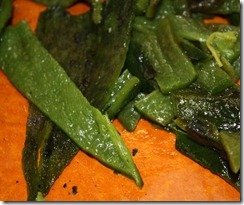 There at left are the poblano peppers (also sometimes called pasilla) – I sliced them much thinner than shown here – they needed to be 2” x 1/4 inch strips. I sautéed them in a frying pan briefly – I think that’s done to make sure they’re cooked through during the baking process.
There at left are the poblano peppers (also sometimes called pasilla) – I sliced them much thinner than shown here – they needed to be 2” x 1/4 inch strips. I sautéed them in a frying pan briefly – I think that’s done to make sure they’re cooked through during the baking process.
The thinly sliced potatoes are layered in a large casserole dish (make sure it has much higher sides than you think as these kinds of potatoes often bubble over during baking) along with the corn (I used Trader Joe’s fire-roasted frozen ones plus a bit from a fresh ear of corn), cheese and chiles. The original recipe called for Oaxacan cheese – I have no idea what that is. Or it suggested whole milk mozzarella. I didn’t have that either, so decided to use a combination of Monterey Jack and Fontina – both good melting cheeses. The half and half mixture (with salt and pepper) is poured in on top and some cheese is reserved for later. It was covered in foil and baked for 30 minutes. Then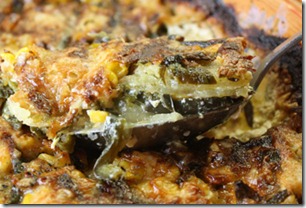 I removed the foil, added the reserved cheese and it baked another 25 minutes or so. I tested it and found it needed a little longer in the oven. About another 15 minutes and it was done. It sat out on my kitchen counter for at least 20-30 minutes before it was served (our pork roast took longer than I thought it would) and it was still piping hot.
I removed the foil, added the reserved cheese and it baked another 25 minutes or so. I tested it and found it needed a little longer in the oven. About another 15 minutes and it was done. It sat out on my kitchen counter for at least 20-30 minutes before it was served (our pork roast took longer than I thought it would) and it was still piping hot.
What I liked: the combo of flavors – the poblanos add a stringent taste, as peppers do. Corn added some nice color and texture. Loved the cheese. DO not under-salt this dish – potatoes need a lot of salt, if you haven’t noticed. A very nice company casserole.
What I didn’t like: gosh, nothing really. I thought the leftovers were even better than the first serving of these. I’d make this again. Probably add more cheese.
printer-friendly PDF
MasterCook 5+ import file – right click to save file, run MC, then File|Import
Poblano, Potato and Corn Gratin
Recipe By: From Bon Appetit, 2010
Serving Size: 8-9
3 teaspoons olive oil — divided
3 large poblano peppers — stemmed, seeded, cut into 2 x 1/4-inch strips
1 1/4 pounds Yukon Gold potatoes — peeled, cut into 1/8-inch-thick rounds
2 cup frozen corn kernels — thawed
3 cup grated cheese — [I used half Fontina, half Monterey Jack]
1 3/4 cups half and half
2 1/2 tablespoons all purpose flour
1 teaspoon salt
3/4 teaspoon freshly ground black pepper
1. Preheat oven to 400°F. Rub 9 1/2-inch-diameter deep-dish glass pie dish or cast-iron skillet with 2 teaspoons oil. Heat remaining 1 teaspoon oil in large nonstick skillet over medium-high heat. Add poblano strips and sauté until tender, about 5-8 minutes. Remove from heat.
2. Arrange 1/3 of potato rounds, overlapping slightly, in prepared pie dish. Sprinkle 1/3 of poblano strips over, then 1/3 of corn and 1/3 of cheese. Repeat with 1/3 of potatoes, 1/3 of poblanos, 1/3 of corn, and 1/3 of cheese. Top with remaining potatoes, poblanos, and corn, reserving remaining 1/3 of cheese. Place pie dish on rimmed baking sheet.
3. Whisk half and half, flour, salt, and freshly ground black pepper in small bowl. Pour over potato mixture in pie dish; press potatoes to submerge. Cover dish tightly with foil. Bake 30 minutes. Remove foil; sprinkle remaining cheese over gratin. Continue to bake gratin until potatoes are tender and cheese is golden brown, about 25 minutes longer. Let stand 10 minutes before serving.
Per Serving: 327 Calories; 20g Fat (53.4% calories from fat); 14g Protein; 25g Carbohydrate; 2g Dietary Fiber; 57mg Cholesterol; 497mg Sodium.




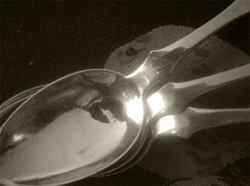
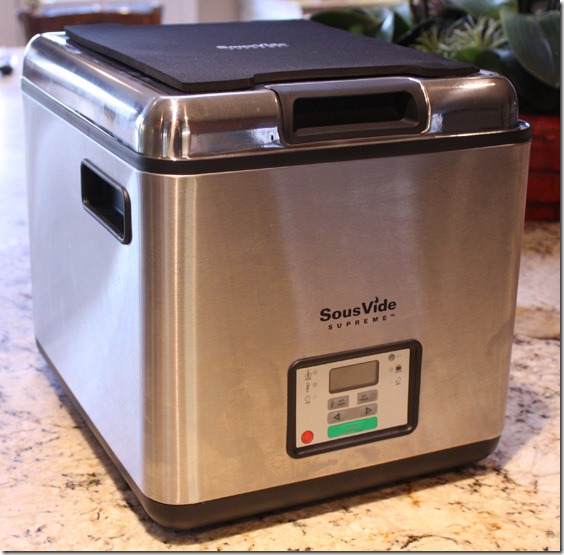

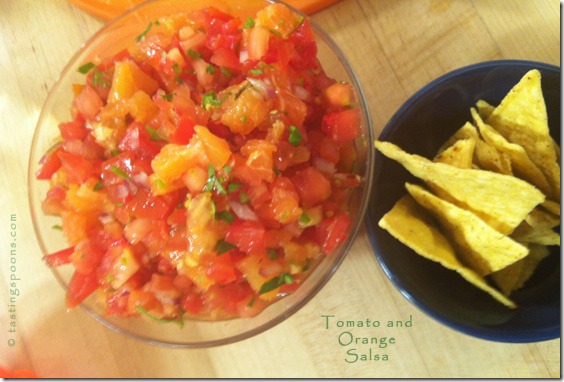


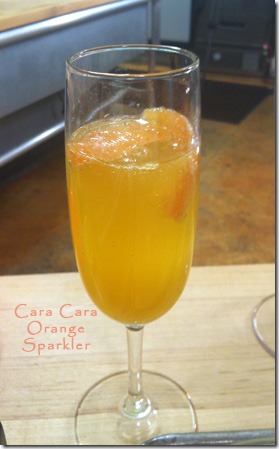

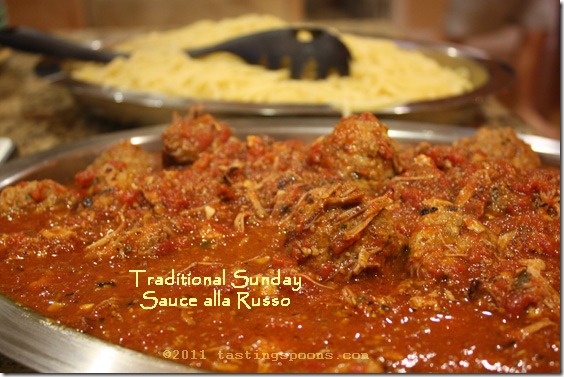
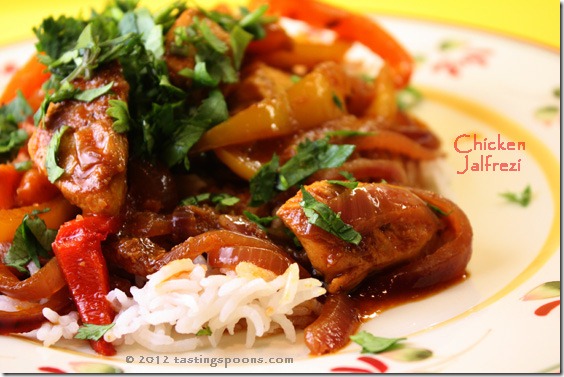
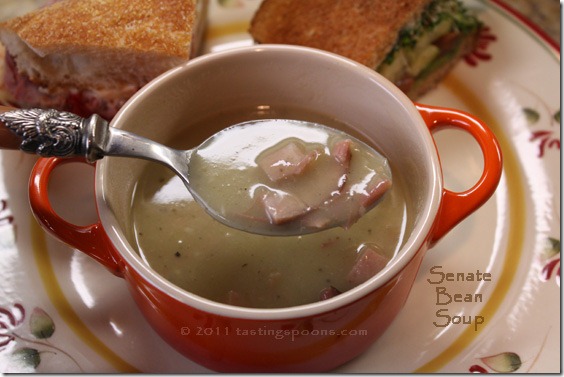
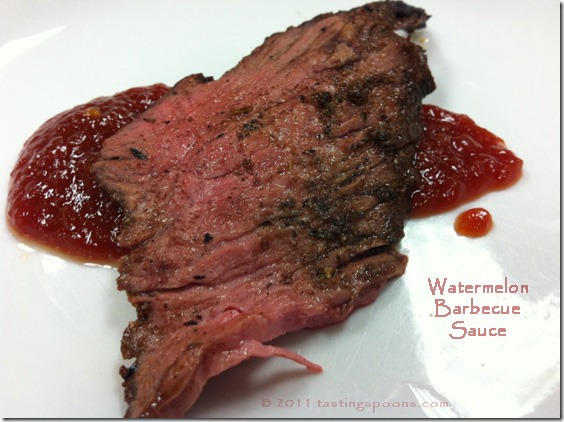
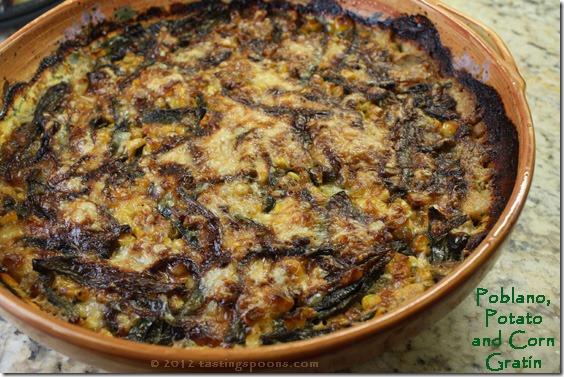
Leave a Comment!